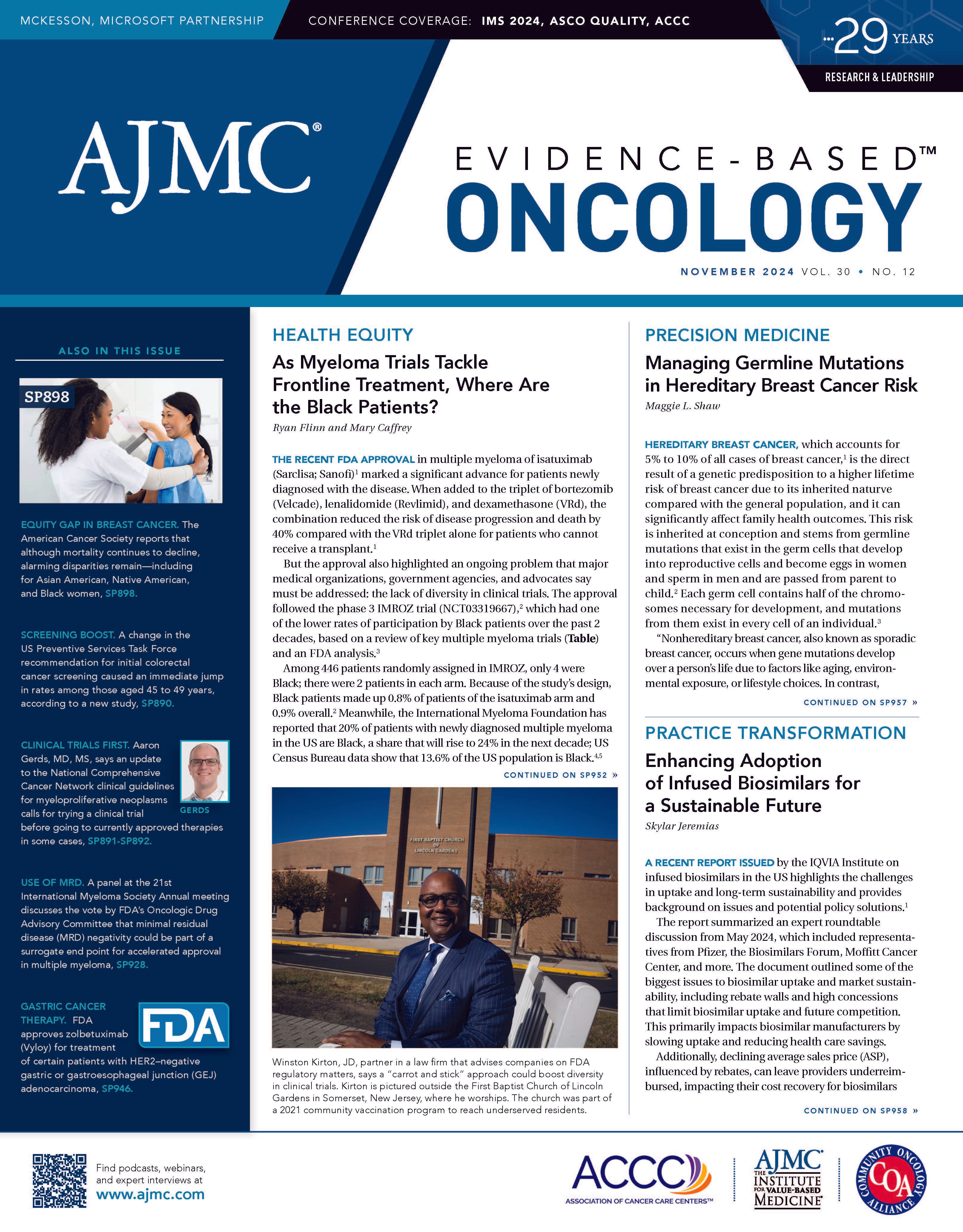- Center on Health Equity & Access
- Clinical
- Health Care Cost
- Health Care Delivery
- Insurance
- Policy
- Technology
- Value-Based Care
How Do Community Oncologists View the Use of MRD Testing?
Investigators from Florida Cancer Specialists & Research Institute explored questions surrounding minimal residual disease (MRD) negativity testing in an abstract presented at the International Myeloma Society 21st Annual Meeting & Exposition.
The decision by FDA’s Oncologic Drugs Advisory Committee to endorse use of minimal residual disease (MRD) as an end point in clinical trials for accelerated approval of new treatments for multiple myeloma (MM) is considered a watershed event for those who study and treat patients with MM.1
But how will this translate into decision-making in clinical practice? Results presented in a poster at the 21st International Myeloma Society Annual Meeting (IMS 2024) offer some insight.
Lucio N. Gordan, MD | Image credit: Florida Cancer Specialists & Research Institute

Investigators at Florida Cancer Specialists & Research Institute surveyed 22 physicians across the practice, which has 100 sites and is well known for its phase 1 clinical trials program.2 The abstract, “Perspectives of Single-Center Community Hematologists/Oncologists on Minimal Residual Disease Testing Among Patients With Multiple Myeloma,” explores perspectives on MRD testing, barriers to testing, and use of test results for clinical decision-making. Janssen Scientific Affairs, LLC funded the study.3
Of the physicians taking part in the survey, 86% had more than 5 years’ experience treating patients with MM and 73% said they were comfortable or very comfortable ordering MRD tests. The median number of tests ordered between September 2019 and October 2023 per physician was 2.5.3
Physicians ranked the reasons they ordered MRD tests as follows: to monitor remission status (91%), to detect MM recurrence (59%), and to aid in treatment decision-making (50%). The most common barriers to testing cited were logistics of sending samples to MRD testing facilities (96%), lack of insurance coverage (73%), lack of local testing facilities (68%), and unfamiliarity with next steps based on results (32%).3
Most physicians in the survey noted that they only order MRD testing if it’s covered by insurance (82%) and that they consider MRD testing essential for patients with high-risk cytogenetics (59%). Most (77%) also reported that they consider MRD negativity an acceptable end point in clinical trials; 18% preferred the use of overall survival, and 5% preferred progression-free survival.3
For additional insights on the results, The American Journal of Managed Care (AJMC) contacted Lucio N. Gordan, MD, president and managing physician at Florida Cancer Specialists & Research Institute and lead author on the abstract. Gordan answered questions via email on behalf of the research team.
AJMC: Your survey covered a time frame during which MRD testing had become more common. Did the number of tests the doctors ordered increase over the duration of the survey?
Gordan: The number of tests ordered increased as expected, organically, [over the] duration [of] the survey but not as a consequence from the survey. The results of the survey and abstract will be disseminated to providers soon, after the IMS presentation.
AJMC: Most of your physicians stated that MRD tests were especially important for patients with high-risk cytogenetics. Can you discuss why testing for these patients is especially important?
Gordan: This is a high-risk population with poorer outcomes. Hence, having more data points for earlier detection of recurrence or for risk assessment and determination of response are important. For instance, a patient with less-than-complete molecular remission may be followed more often or receive more aggressive maintenance therapy or enrolled in a clinical trial. For patients with early molecular recurrence, earlier treatment intervention may be recommended. Naturally, health care providers and patients generally desire a more aggressive approach in the management of high-risk disease biology.
AJMC: Your survey found that lack of insurance coverage was a common reason why testing might not be performed—yet your physicians reported that if testing showed a patient was in remission, they might give patients a break from treatment. Are payers understanding that this testing might lead to lower costs?
Gordan: I am sure that payers understand that a negative MRD [test] may allow a health care provider to de-escalate therapy. The cost of therapy is significantly higher than the cost of testing for MRD. However, this is not yet fully endorsed by national guidelines. These data continue to evolve. How to best treat such patients, including de-escalation of maintenance therapy, when, how, which drugs remain in this setting, are a matter of ongoing studies. The same applies to initial therapy. Should one move to maintenance therapy immediately after MRD is achieved? Or when is it the best time to make such a transition from initial therapy to maintenance? Until these questions are clearly answered, it is difficult and controversial to navigate this space. Ideally, enrollment in clinical trials is the only proper way to answer these questions.
AJMC: Your survey found that 77% of the physicians were comfortable using MRD negativity as a clinical trial end point. How will use of MRD negativity as an end point benefit patients?
Gordan: This is a great question. There is a huge variability here. Some physicians use negative MRD as a prognostic factor primarily. Others may be more aggressive and change therapy based on MRD results. We do not have internal granular data yet. Again, only national guidelines based on prospective randomized trials can answer these questions properly. The science continues to evolve at a fast pace, but this remains a big question mark in physicians’ decision-making process. Several times when patients are followed by academic centers in conjunction with us, we see variability in recommendations. We continue to apply evolving knowledge and discuss pros/cons of testing, limitations, and applicability. The whole subject of MRD testing is fascinating to me and will change how we practice medicine in cancer care, not limited to multiple myeloma but also many solid tumors. However, recommendations of therapy changes, initiation, escalation, de-escalation must be based on scientific evidence.
References
1. Seymour C. FDA’s ODAC recognizes MRD as an accepted end point for accelerated approval in multiple myeloma. OncLive. April 12, 2024. Accessed October 15, 2024. https://www.onclive.com/view/fda-s-odac-recognizes-mrd-as-an-accepted-end-point-for-accelerated-approval-in-multiple-myeloma
2. About FCS. Florida Cancer Specialists & Research Institute. Accessed October 19, 2024. https://flcancer.com/about-fcs/
3. Gordan LN, Warner A, Heritage T, et al. MM-318 perspectives of single-center community hematologists/oncologists on minimal residual disease testing among patients with multiple myeloma. Clin Lymphoma Myeloma Leuk. 2024;24(suppl 1):S564. doi:10.1016/S2152-2650(24)01663-X

